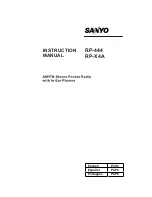
-3-
Section 9
FM RF
AMPLIFIER
FM
OSCILLATOR
1ST FM IF
AMPLIFIER
AFC
Figure 1
Section 8
Section 7
Section 6
Section 1
Section 5
Section 4
Section 3
Section 2
FM MIXER
2ND FM IF
AMPLIFIER
FM
DETECTOR
AM MIXER
AM
OSCILLATOR
1ST AM IF
AMPLIFIER
2ND AM IF
AMPLIFIER
AM
DETECTOR
AFC
AUDIO
AMPLIFIER
Speaker
FM RADIO
AM RADIO
The purpose of section 1, the Audio Amplifier Stage, is to
increase the power of the audio signal received from the
detector to a power level capable of driving the speaker.
Section 2 includes the AM detector circuit and the AGC
(automatic gain control) circuit. The AM detector converts
the amplitude modulated IF (intermediate frequency)
signal to a low level audio signal. The AGC stage feeds
back a DC voltage to the first AM IF amplifier in order to
maintain a near constant level of audio at the detector.
Section 3 is the second AM IF amplifier. The second AM
IF amplifier is tuned to 455kHz (Kilohertz) and has a fixed
gain at this frequency of 50. Section 4 is the first AM IF 2
amplifier which has a variable gain that depends on the
AGC voltage received from the AGC stage. The first AM
IF amplifier is also tuned to 455kHz. Section 5 includes
the AM mixer, AM oscillator and AM antenna stages.
When the radio wave passes through the antenna, it
induces a small voltage across the antenna coil. This
voltage is coupled to the mixer, or converter, stage to be
changed to a frequency of 455kHz. This change is
accomplished by mixing (heterodyning) the radio
frequency signal with the oscillator signal. Section 6 is the
FM ratio detector circuit. The FM ratio detector has a fixed
gain of about 20. Section 7 is the second FM IF amplifier.
The second FM IF amplifier is tuned to 10.7MHz
(Megahertz) and has a set gain of approximately 20. The
3dB bandwidth of this stage should be approximately
350kHz. Section 8 is the first FM IF amplifier. The first FM
IF amplifier is also tuned to 10.7MHz and has a set gain of
approximately 10. It also has a 3dB bandwidth of 350kHz.
Section 9 includes the FM mixer, FM oscillator, FM RF and
the AFC circuits. The incoming radio waves are amplified
by the FM RF amplifier, which is tuned to a desired radio
station in the FM frequency bandwidth of 88MHz to
108MHz. These amplified signals are then coupled to the
FM mixer stage to be changed to a frequency of 10.7MHz.
This change, as in AM, is accomplished by heterodyning
the radio frequency signal with the oscillator signal. The
AFC stage feeds back a DC voltage to the FM oscillator to
prevent the oscillator from drifting. Each of these blocks
will be explained in detail in the Theory of Operation given
before the assembly instructions for that stage.
GENERAL DISCUSSION
INTRODUCTION
The Elenco
®
Superhet 108T AM/FM Radio Kit is a
“superheterodyne” receiver of the standard AM (amplitude
modulation) and FM (frequency modulation) broadcast
frequencies. The unique design of the Superhet 108
allows you to place the parts over their corresponding
symbol in the schematic drawing on the surface of the
printed circuit board during assembly. This technique
maximizes the learning process while keeping the
chances of an assembly error at a minimum. It is very
important, however, that good soldering practices are
used to prevent bad connections. The Soldering Guide
should be reviewed before any soldering is attempted.
The actual assembly is broken down into 9 sections. The
theory of operation for each section, or stage, should be
read before the assembly is started. This will provide the
student with an understanding of what that stage has been
designed to accomplish, and how it actually works. After
each assembly, you will be instructed to make certain tests
and measurements to prove that each section is
functioning properly. If a test fails to produce the proper
results, a troubleshooting guide is provided to help you
correct the problem. If test equipment is available, further
measurements and calculations are demonstrated to
allow each student to verify that each stage meets the
engineering specifications. After all of the stages have
been built and tested, a final alignment procedure is
provided to peak the performance of the receiver and
maximize the Superhet 108T’s reception capabilities.





































